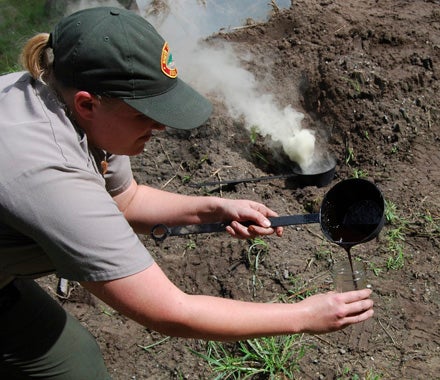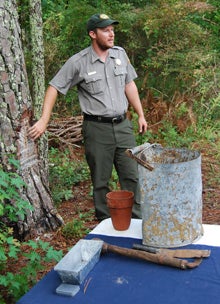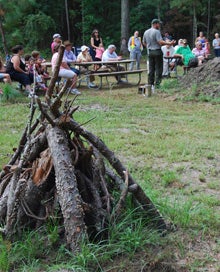Park program explores the naval stores industry
Published 9:12 am Sunday, September 13, 2015

SHARING HISTORY: Environmental specialist Joe Hawley explains the history of tar kilns and their importance to the naval stores industry during a special Labor Day program.
A special Labor Day program at Goose Creek State Park focused on an industry that once thrived in Beaufort County, an industry that aided the survival of many early settlers.
Environmental specialist Joe Hawley and ranger Nicole Crider presented the program, titled “Tar Kilns and Turpentine — A Labor Day Celebration”, to more than 30 park visitors interested in the park’s natural resources and its history.
The state park is home to quite a few tar kilns dating as far back as the 18th century, according to Hawley.
“We’ve found about 60 kilns so far in Goose Creek,” he told those gathered for the program Monday morning. “Settlers built the kilns where trees and limbs had fallen or where they found stumps.”

STRAIGHT FROM THE KILN: Ranger Nicole Crider pours tar from a kiln. Once it cools, the tar thickens and becomes sticky.
Hawley describes those aged kilns as usually being around 30 feet wide and circular, with a depression in the middle of the mounds.
Hawley said settlers valued “lighterwood”, or wood heavy with resin, in order to produce tar, pitch and turpentine for the naval stores industry. The wood would be stacked in a tee pee style, then covered with green long leaf pine limbs before a final layer of soil was piled on. A hole was left in the top so that a fire could be lighted from the center.
“It was insulated and it would get really hot,” Hawley explained. “Two hundred years ago, it would take four or five people to watch it for nine or 10 days. You had to be watching it all the time … they had to be on their toes.”
A sloped area in the kiln allowed the tar to seep out and the settlers gathered the product in barrels.
“It was used to waterproof ships and waterproof ropes,” Hawley said. “If there was a hole in a ship, they would pack it with horsehair and then cover it with the tar or pitch.
For educational purposes, park personnel have designed and built a reproduction tar kiln for use in programs for the public. That has allowed them to speed up the process of manufacturing tar and pitch.
Crider shared a legend that offers one explanation for how North Carolina became known as the Tar Heel State. Although there are several versions of the origin of the nickname, Crider noted that North Carolina soldiers during the Civil War were admired by their fellow soldiers for standing firm on the battlefield.
“It was said they were either crazy or it was the tar on their feet that made them hold their ground,” she said.
Hawley also noted that the state’s long leaf pine trees proved to be a source for another valuable commodity. Settlers would hack trees to keep the resin flowing; a funnel inserted in the tree allowed them to gather the resin in cups. That resin was important in the manufacturing of turpentine, which was used not only for paint thinner but for some medicinal purposes as well.

TURPENTINE: Joe Hawley shares how early settlers harvested resin from long leaf pines in order to make turpentine.
“Long leaf pines were perfect for the tar industry,” Hawley said.
**Goose Creek State Park hosts free programs for the public on a regular basis. Two hikes are planned for later this month, as well as a program spotlighting the area’s native snake population. For more information, call 252-923-2191.






